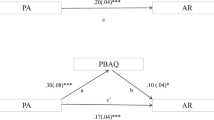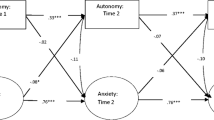Abstract
The current study examined relations between parent anxiety and child anxiety, depression, and externalizing symptoms. In addition, the study tested the additive and interactive effects of parent anxiety with parent depression and externalizing symptoms in relation to child symptoms. Forty-eight parents with anxiety disorders and 49 parents without any psychiatric disorder participated with one of their children (ages 6 to 14 years; 46.4% male; 75.8% Caucasian). Parent anxiety was related to both child anxiety and depression, but not child externalizing symptoms. Hierarchical regression analyses showed that only parent externalizing symptoms had additive effects, beyond parent anxiety symptoms, in relation to child anxiety symptoms. Further, parent anxiety symptoms moderated the relationship between parent and child externalizing symptoms, such that the strength of this relationship was reduced in the presence of high levels of parent anxiety symptoms. Results of this study illuminate the role of parent comorbidity in understanding relations between parent and child symptoms.

Similar content being viewed by others
Notes
Notably, a number of studies involving community or clinically-referred youth have tested relations between parent psychopathology and child problems at the symptom rather than diagnostic level (e.g., Costa and Weems 2005; Costa et al. 2006). However, no studies of which we are aware have examined these relations in a high-risk design sample and none to our knowledge have examined the incremental contribution of different types of parent symptoms to relations between parent anxiety and child symptoms.
All analyses involved participant data from the baseline assessment before involvement in the preventive intervention study.
Many children with a psychiatric disorder had more than one diagnosis. As such, frequency counts are not mutually exclusive.
Hierarchical linear regressions were also conducted without male parents. Because results were similar, they are presented for the entire sample.
References
Achenbach, T. M. (1998). Diagnosis, assessment, and taxonomy. In T. H. Ollendick & M. Herson (Eds.), Handbook of child psychopathology (pp. 63–87). New York: Plenum.
Achenbach, T. M., & Rescorla, L. A. (2001). Manual for ASEBA school-age forms and profiles. Burlington: Univeristy of Vermont, Research Center for Children, Youth, and Families.
Aiken, L. S., & West, S. G. (1991). Multiple regression: Testing and interpreting interactions. Newbury Park: Sage.
Beidel, D. C., & Turner, S. M. (1997). At risk for anxiety: I. Psychopathology in the offspring of anxious parents. Journal of the American Academy of Child and Adolescent Psychiatry, 36(7), 918–924.
Berman, M. E., Fallon, A. E., & Coccaro, E. F. (1998). The relationship between personality psychopathology and aggressive behavior in research volunteers. Journal of Abnormal Psychology, 107(4), 651–658.
Berman, S. L., Weems, C. F., Silverman, W. K., & Kurtines, W. M. (2000). Predictors of outcome in exposure-based cognitive and behavioral treatments for phobic and anxiety disorders in children. Behavior Therapy, 31(4), 713–731.
Biederman, J., Rosenbaum, J. F., Bolduc, E. A., Faraone, S. V., & Hirshfeld, D. R. (1991). A high risk study of young children of parents with panic disorder and agoraphobia with and without comorbid major depression. Psychiatry Research, 37(3), 333–348.
Biederman, J., Petty, C., Hirshfeld-Becker, D. R., Henin, A., Faraone, S. V., Dang, D., et al. (2006). A controlled longitudinal 5-year follow-up study of children at high and low risk for panic disorder and major depression. Psychological Medicine, 36(8), 1141–1152.
Birmaher, B., Khetarpal, S., Brent, D., Cully, M., Balach, L., Kaufman, J., et al. (1997). The screen for child anxiety related emotional disorders (SCARED): Scale construction and psychometric characteristics. Journal of the American Academy of Child and Adolescent Psychiatry, 36(4), 545–553.
Brown, T. A., DiNardo, P. A., & Barlow, D. H. (1994). Anxiety disorders interview schedule for DSM-IV. New York: Graywind.
Burstein, M., Stanger, C., Kamon, J., & Dumenci, L. (2006). Parent psychopathology, parenting, and child internalizing problems in substance-abusing families. Psychology of Addictive Behaviors, 20, 97–106.
Chassin, L., Pitts, S. C., & Prost, J. (2002). Binge drinking trajectories from adolescence to emerging adulthood in a high-risk sample: Predictors and substance abuse outcomes. Journal of Consulting and Clinical Psychology, 70, 67–78.
Cicchetti, D., & Rogosch, F. A. (1996). Equifinality and multifinality in developmental psychopathology. Development and Psychopathology, 8, 597–600.
Cobham, V. E., Dadds, M. R., & Spence, S. H. (1998). The role of parental anxiety in the treatment of childhood anxiety. Journal of Consulting and Clinical Psychology, 66(6), 893–905.
Cohen, J. (1992). A power primer. Psychological Bulletin, 112, 155–159.
Cook, R. D. (1977). Detection of influential observations in linear regression. Technometrics, 19, 15–18.
Costa, N. M., & Weems, C. F. (2005). Maternal and child anxiety: do attachment beliefs or children’s perceptions of maternal control mediate their association? Social Development, 14, 574–590.
Costa, N. M., Weems, C. F., Pellerin, K., & Dalton, R. (2006). Parenting stress and childhood psychopathology: an examination of specificity to internalizing and externalizing symptoms. Journal of Psychopathology and Behavioral Assessment, 28, 113–122.
Derogatis, L. (1993). The brief symptom inventory. Minneapolis: National Computer Systems, Inc.
Derogatis, L. R., & Melisaratos, N. (1983). The Brief Symptom Inventory: an introductory report. Psychological Medicine, 13, 596–605.
Dogan, S. J., Conger, R. D., Kim, K. J., & Masyn, K. E. (2007). Cognitive and parenting pathways in the transmission of antisocial behavior from parents to adolescents. Child Development, 78, 335–349.
Fisak, B., & Grills-Taquechel, A. E. (2007). Parental modeling, reinforcement, and information transfer: risk factors in the development of child anxiety? Clinical Child and Family Psychology, 10, 213–231.
Ginsburg, G. S. (2009). The child anxiety prevention study: intervention model and primary outcomes. Journal of Consulting and Clinical Psychology, 77, 580–587.
Ginsburg, G. S., & Schlossberg, M. C. (2002). Family-based treatment of childhood anxiety disorders. International Review of Psychiatry, 14, 143–154.
Goodman, S. H., & Gotlib, I. H. (1999). Risk for psychopathology in the children of depressed mothers: a developmental model for understanding mechanisms of transmission. Psychological Review, 106, 458–490.
Goodman, S. H., Adamson, L. B., Riniti, J., & Cole, S. (1994). Mothers’ expressed attitudes: associations with maternal depression and children’s self-esteem and psychopathology. Journal of the American Academy of Child and Adolescent Psychiatry, 33(9), 1265–1274.
Goodwin, R. D., & Hamilton, S. P. (2003). Lifetime comorbidity of antisocial personality disorder and anxiety disorders among adults in the community. Psychiatry Research, 117(2), 159–166.
Gregory, A. M., & Eley, T. C. (2007). Genetic influences on anxiety in children: what we’ve learned and where we’re heading. Clinical Child and Family Psychology, 10, 199–212.
Hammen, C. (1991). Depression runs in families: The social context of risk and resilience in children of depressed mothers. New York: Springer-Verlag.
Hicks, B. M., Krueger, R. F., Iacono, W. G., McGue, M., & Patrick, C. J. (2004). Family transmission and heritability of externalizing disorders. Archives of General Psychiatry, 61, 922–928.
Howell, D. C. (2002). Multiple regression. In C. Crockett & A. Day (Eds.), Statistical methods for psychology (pp. 533–601). Pacific Grove: Thomson Learning.
Katz, L. F., & Low, S. M. (2004). Marital violence, co-parenting, and family-level processes in relation to children’s adjustment. Journal of Family Psychology, 18(2), 372–382.
Kendall, P. C., Hudson, J. L., Gosch, E., Flannery-Schroeder, E., & Suveg, C. (2008). Cognitive-behavioral therapy for anxiety disordered youth: a randomized clinical trial evaluating child and family modalities. Journal of Consulting and Clinical Psychology, 76(2), 282–297.
Kessler, R. C., Chiu, W. T., Demler, O., Merikangas, K. R., & Walters, E. E. (2005a). Prevalence, severity, and comorbidity of 12-month DSM-IV disorders in the national comorbidity survey replication. Archives of General Psychiatry, 62(6), 617–627.
Kessler, R. C., Demler, O., Frank, R. G., Olfson, M., Pincus, H. A., Walters, E. E., et al. (2005b). Prevalence and treatment of mental disorders, 1990 to 2003. New England Journal of Medicine, 352(24), 2515–2523.
Kohr, R. L., & Games, P. A. (1974). Robustness of the analysis of variance, the Welch procedure and a box procedure to heterogeneous variances. Journal of Experimental Education., 43, 61–69.
Kovacs, M. (1992). Children’s depression inventory manual. North Tonawanda: Multi-health Systems.
Loney, B. R., Huntenburg, A., Counts-Allan, C., & Schmeelk, K. M. (2007). A preliminary examination of the intergenerational continuity of maternal psychopathic features. Aggressive Behavior, 33(1), 14–25.
MacCallum, R. C., Zhang, S., Preacher, K. J., & Rucker, D. (2002). On the practice of dichotomization of quantitative variables. Psychological Methods, 7, 19–40.
Marmorstein, N. R., Malone, S. M., & Iacono, W. G. (2004). Psychiatric disorders among offspring of depressed mothers: associations with paternal psychopathology. American Journal of Psychiatry, 161(9), 1588–1594.
Merikangas, K. R., Dierker, L. C., & Szatmari, P. (1998). Psychopathology among offspring of parents with substance abuse and/or anxiety disorders: a high-risk study. Journal of Child Psychology and Psychiatry and Allied Disciplines, 39(5), 711–720.
Merikangas, K. R., Avenevoli, S., Dierker, L., & Grillon, C. (1999). Vulnerability factors among children at risk for anxiety disorders. Biological Psychiatry, 46(11), 1523–1535.
Neter, J., Kutner, M., & Wasserman, W. (1989). Applied linear regression analysis. Chicago: Irwin.
Patterson, G. R., & Capaldi, D. M. (1991). Antisocial parents: Unskilled and vulnerable. In P. A. Cowan & E. M. Hetherington (Eds.), Family transitions: Advances in family research series (pp. 195–218). Hillsdale: Erlbaum.
Patterson, G. R., DeBaryshe, B. D., & Ramsey, E. (1989). A developmental perspective on antisocial behavior. American Psychologist, 44(2), 329–335.
Rice, F., Harold, G., & Thapar, A. (2002). The genetic aetiology of childhood depression: a review. Journal of Child Psychology and Psychiatry, 43, 65–79.
Rodriguez, C. M. (2003). Parental discipline and abuse potential affects on child depression, anxiety, and attributions. Journal of Marriage and Family, 65(4), 809–817.
Rutter, M. (1979). Protective factors in children’s responses to stress and disadvantage. Annals of the Academy of Medicine, Singapore, 8(3), 324–338.
Sameroff, A. J. (2000). Dialectical processes in developmental psychopathology. In A. Sameroff, M. Lewis, & S. Miller (Eds.), Handbook of developmental psychopathology (2nd ed., pp. 23–40). New York: Kluwer/Plenum.
Sareen, J., Stein, M. B., Cox, B. J., & Hassard, S. T. (2004). Understanding comorbidity of anxiety disorders with antisocial behavior: findings from two large community surveys. Journal of Nervous and Mental Disease, 192(3), 178–186.
Silverman, W. K., & Albano, A. M. (1996). The anxiety disorders interview schedule for DSM-IV: child and parent versions. San Antonio: Psychological Corporation.
Silverman, W. K., Cerny, J. A., Nelles, W. B., & Burke, A. E. (1988). Behavior problems in children of parents with anxiety disorders. Journal of the American Academy of Child and Adolescent Psychiatry, 27(6), 779–784.
Stevens, J. P. (1984). Outliers and influential data points in regression analysis. Psychological Bulletin, 95, 334–344.
Sylvester, C. E., Hyde, T. S., & Reichler, R. J. (1988). Clinical psychopathology among children of adults with panic disorder. In D. L. Dunner, E. S. Gershon, & J. E. Barrett (Eds.), Relatives at Risk for Mental Disorder (Volume 26, pp. 87–102). New York: Raven Press.
Turner, S. M., Beidel, D. C., & Costello, A. (1987). Psychopathology in the offspring of anxiety disorders patients. Journal of Consulting and Clinical Psychology, 55(2), 229–235.
Warner, V., Mufson, L., & Weissman, M. M. (1995). Offspring at high and low risk for depression and anxiety: mechanisms of psychiatric disorder. Journal of the American Academy of Child and Adolescent Psychiatry, 34(6), 786–797.
West, S. G., Finch, J. F., & Curran, P. J. (1995). Structural equation models with non-normal variables. Thousand Oaks: Sage.
Wood, J. J., McLeod, B. D., Sigman, M., Hwang, W. C., & Chu, B. C. (2003). Parenting and child anxiety: theory, empirical findings, and future directions. Journal of Child Psychology and Psychiatry, 44, 134–151.
Author information
Authors and Affiliations
Corresponding author
Additional information
An erratum to this article can be found at http://dx.doi.org/10.1007/s10802-010-9455-5
Rights and permissions
About this article
Cite this article
Burstein, M., Ginsburg, G.S. & Tein, JY. Parental Anxiety and Child Symptomatology: An Examinzation of Additive and Interactive Effects of Parent Psychopathology. J Abnorm Child Psychol 38, 897–909 (2010). https://doi.org/10.1007/s10802-010-9415-0
Published:
Issue Date:
DOI: https://doi.org/10.1007/s10802-010-9415-0




